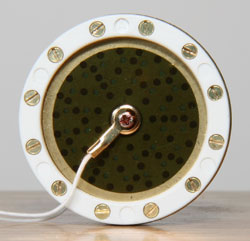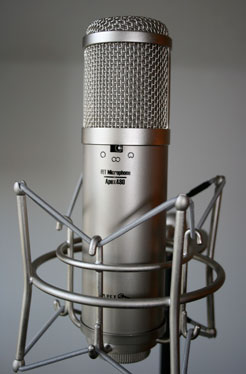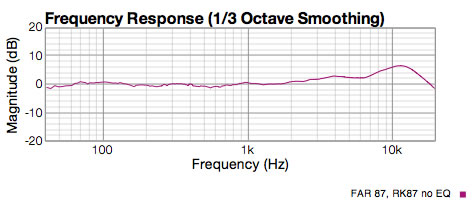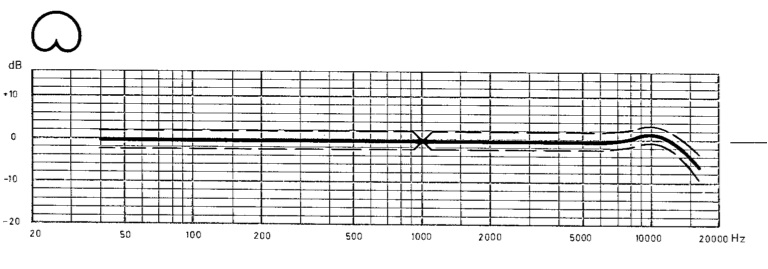The FAR 87
Cloning the workhorse of the industry

The Neumann u87 microphone was created in 1972 as a solid state replacement for the u67 tube mic. You can see a video of how they are made here.
When you think of recording studio microphones the Neumann u87 is probably the most common microphone in use in professional studios. Some say it doesn't sound amazing on everthing but it will always sound good on anything.
The u87 was created as the solid state version of the u67, a tube microphone. The u67 was created in 1961 when Telefunken informed Neumann that the VF14 tube they used in the famous u47 microphone would no longer be manufactured. Neumann needed a replacement product and took the opportunity to create a modern looking package and they also radically changed their thinking in how to produce a condenser microphone.
Before the u67 was invented, the u47 microphone used a capsule that had the holes drilled in the back plate so that the frequency response of the capsule would be flat, or as flat as they could make it. This requires a complex pattern of holes with different sizes, some drilled through and others blind, that is complicated and expensive to make, especially before the days of computer controlled milling machines.
 .......
....... 
RK47 capsule hole pattern versus RK87 hole pattern
With the new u67/u87 capsule they went with a mathematically organized set of holes but the side effect of that hole arrangement is the frequency response of the capsule rises slowly above 2KHz to a maximum of about 6dB at 10 to 11 KHz. What to do?
Turns out this rising response is very precise and can be compensated for in the internal preamp quite easily! The side effect of this is that you also get an improved signal to noise ratio in the high end of the circuit. Bonus!
So that is the history that led to where this story is going. When we decided to see if we could create u87 clone, we knew we needed a u87 style capsule and we knew we had to EQ the preamp. It turns out that the good people at microphone parts.com just completed a new design and so we got some in straight away.
We installed the new 87 style capsule in an APEX 480 microphone. Why? Like the APEX 460 the 480 is built like a tank and it comes with a shockmount and plastic flight case so it's a complete package.
The APEX 480 also has a three polar pattern circuit like the u87. Now understand it does not work the same way as the u87. We know that, but it does provide the Cardiod, Omni and Figure 8 switching that a u87 clones uses. It also provides a high pass filter switch and a 10dB Pad to match those features as well.

There other places where the 480 is very different than the u87. The u87 did not have a DC convertor to create the polarization voltages on the capsule but instead relied on the 48 volt phantom supply from the mixer (or internal batteries). And the preamp in the u87 used a single FET, whereas the 480 uses a FET for the front end and has a second transistor, a low noise bi-polar, in an emitter follower configuration to drive the transformer. All that said, they are very different beasties, but the with component changes and adjustments to the emitter follower circuit, the APEX 480 preamp can be turned into a very clean preamp and that has more impact to my ear than the exact nature of how you get that clean sound. Others may disagree with that position, but we are talking about getting a $150 dollar microphone to sound similar to a $4000 microphone so some comprimising has to be done somewhere. :-)
So after pimping out the APEX 480 preamp with polystyrene input caps and Nichicon Muse electrolytics, we installed the RK87 capsule and here is what the sweep looked like.

Notice how the high end rises after 2KHz and is 6dB about 1KHz by the time it gets to 11KHz. This is by design in the u87 capsule and can be called "pre-emphasis".
EQ Corrects the Response
So with a little electronic magic, we altered the response of the first stage in the preamp of the 480 (FET stage) so the the preamp response looked like the graph below. This is called "de-emphasis".

Now if you did that to the preamp of a 47 style microphone it would sound "low fi", muffled with no top end. But the 87 style capsule was built for this so the actual response of the microphone comes out like this:

Below is the published specification graph of the original u87. This graph seems to have been published in 1980. Notice how it is flat from 40Hz all the way to 7KHz with a 0.5dB lift at 10KHz. And the window for error is plus or minus 2dB. Looks like our little FAR 87 would pass muster at Neumann!

Editors Note:
If you check out the published spec of the new u87 ai below, you will find that it is not the same as above. The high end lift starts at 6KHz,is centred on 9Khz and it's +2dB not + 0.5dB! That's why people are saying they don't sound like the old ones. Because they are NOT built the same! And by the way, when Neumann says this is the response... this is THE response that leaves the factory... plus or minus 2 dB as it says on the plot below.

So How Does it Sound?
It was quite uncanny to hear the mic the first time I turned it on. Because it's solid state it has the "stiffer" sound that tube mics don't give you, but the cool thing was the way it had that neutral almost boring sound of a u87. It has a flat response, which in some ways mean little personality.
We created a shootout with our own Prototype 47 Replica edition using the RK47 capsule and the FAR 87. The recordings are just me speaking but you can clearly hear the K47 mid-range push and the more neutral sound of the 87.
FAR 47 Replica Edition Prototype
RK87 Capsule Description
Like the Neumann K67/K87, the RK-87 is a true 34mm, dual-backplate capsule manufactured to very high tolerances. The two backplates are electrically insulated from one another, per u87 specs. It is a 3-micron Mylar, gold metallized, dual-diaphragm capsuleRK87 Specifications
- Capsule diameter: 34 mm
- Diaphragm diameter: 26.7 mm
- Capsule depth: 12.3 mm
- Membrane composition: 3-micron Mylar, sputtered with Gold
- Front/Back Matching
- Sensitivity: ± .3 dB
- Response: ± 1.5 dB
If this microphone interests you send us a note to request a quote at:
